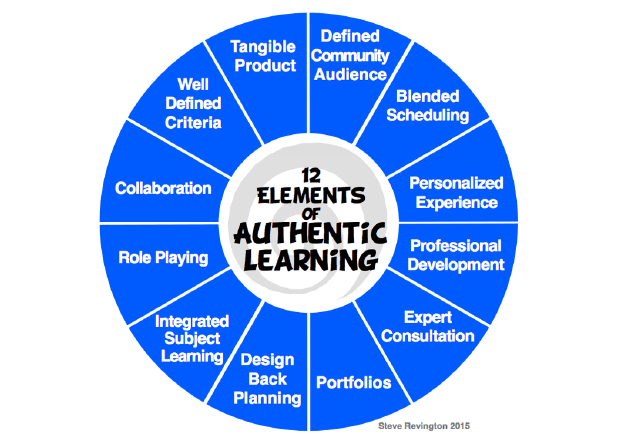Passive learning has been the only way of learning in school for centuries, but experiential and active ways of learning are now at the heart of education. Students often need a motivation to learn when they approach new knowledge and compare it to what they already know. Authentic Learning is learning by participation, learning by focusing on real-world problems. Through Authentic Learning, students connect what they are taught in classroom to practical issues and applications, thus they experience and apply information in ways which are grounded in everyday reality, instead of simply memorizing notions learned in artificial situations.
The digital age with its new technologies undoubtedly plays a substantial role in Authentic Learning. The great amount of information available online nowadays gives students different sources to acquire a vast amount of their skills and knowledge. Students can now access simulation-based learning, have the tools to create online media and work with remote instruments to solve real-world problems. This global connection and the involvement in online communities gives learning a practical dimension which indeed prepares students for the workplace.
In addition, Authentic Learning often takes place outside the classroom: students can travel to a different neighborhood or even to a different country, visit cultural sites, learn from local people to develop language or intercultural skills and learn through creative experiences. But it can also take place effectively in the classroom. Students can learn authentically via drama, role playing, problem-solving, project works, surveys, case-studies and by participating in online communities.
There are four principles of the authentic learning experiences:
- Focusing on realistic problems that “imitate the trade of experts in the field with communication of results to individuals outside the classroom”;
- Basing on an inquiry, with a specific concentration on the metacognitive skills;
- Promoting the participation to conversations in a social and active learning environment;
- Giving the possibility to the learners to make their choices independently and guiding their learning in a context focused on applying specific tasks.
These are referred by Audrey C. Rule, quoted in the paper “Authentic Learning in Adult Education” (Iucu, Marin, 2014).
Herrington et al. (2003) also identified 10 critical characteristics that define the authentic activities approach:
- Correspondence with real world tasks.
- Opening to multiple interpretations because of the presence of ill-defined problems in the activities.
- Investment of time and intellectual resources required in the problem solving of activities.
- Using of various resources, in order to analyse the problem from different perspectives.
- Chance to collaborate.
- Chance to reflect.
- Interdisciplinarity.
- Integration between activities and the assessment of the same ones.
- Creation of a product, not an exercise or a “sub-step in preparation for something else”.
- Possibility of obtaining different solutions and outcomes for a single problem.
Consequently, also a different role for teachers is expected in Authentic Learning. Whereas in the traditional teaching they convey their knowledge providing the basics of their own subject, by choosing the Authentic Learning methodology they can act as facilitators: they set challenges, they give students the freedom to reflect and think outside-the-box, to ask questions, and they help them to learn by interaction and feel. They can be “guides, scaffolders and problem or task presenters” (Iucu, Marin, 2014) but generally it’s possible to say that they have to create both “environments where students are encouraged to think and explore, having access and being invited to make use of various information” and “authentic tasks that provide students with reasons and rationales for learning”. Of course this approach is based on Knowles, Freire, and Mezirow, and even on Dewey and Montessori’s education principles.

Regarding training of teachers, Iucu and Marin (2014) displayed five ways to support authentic learning through Initial Teacher Education (ITC).
- Helping students during critical moments “with coaching and scaffolding”.
- Giving students the chance to reflect.
- Supporting the ideal of the collaboration between students.
- Promoting among the students the verbalization of their knowledge and thinking, so that they can learn more efficiently.
- Enabling and encouraging students in using technologies.
“Learning to Learn By Teaching 2” (L2LByTe2) is an Erasmus + project funded by the European Commission, based on the Grundtvig project “Learning to Learn by Teaching” and linked to two other Grundtvig projects: Vintage and A.L.I.C.E. The L2LByTe2 project aims to respond to a specific need of teachers: to be trained in state-of-the-art methodologies for adult education.
The Hellenic Culture Centre www.hcc.edu.gr (HCC), Greece, participates in this project with a contribution focused on Authentic Learning. In its language schools in Santorini and Athens the HCC applies many Authentic Learning principles, connecting language students with Greek language native speakers and offering students a chance to learn Greek together with Greeks, by participating in everyday life activities (interviewing a local person, cooking, dancing, singing, festivals, painting, social life events).
Through Authentic learning students are more stimulated in carrying out a language task: they use resources that are useful in the realization of real world tasks and, at the same time, they can develop many important language and intercultural skills. This method proves to be particularly efficient as it allows students to connect what they learn in the class to practical issues. It is certainly done better if the students learn a language in its own authentic context, although this is not a sine qua non condition. •
References
- Iucu, R.B., Marin, E. (2014), Authentic Learning in Adult Education, Procedia - Social and Behavioral Sciences 142, pp. 410-415.
- Herrington, J., Oliver R., Reeves, T. C. (2003), Patterns of engagement in authentic online learning environments. Australian Journal of Educational Technology, 19(1), pp. 59-71.
- http://authenticlearning.info/AuthenticLearning/Papers.html
- http://authenticlearning.weebly.com/the-elements.html
